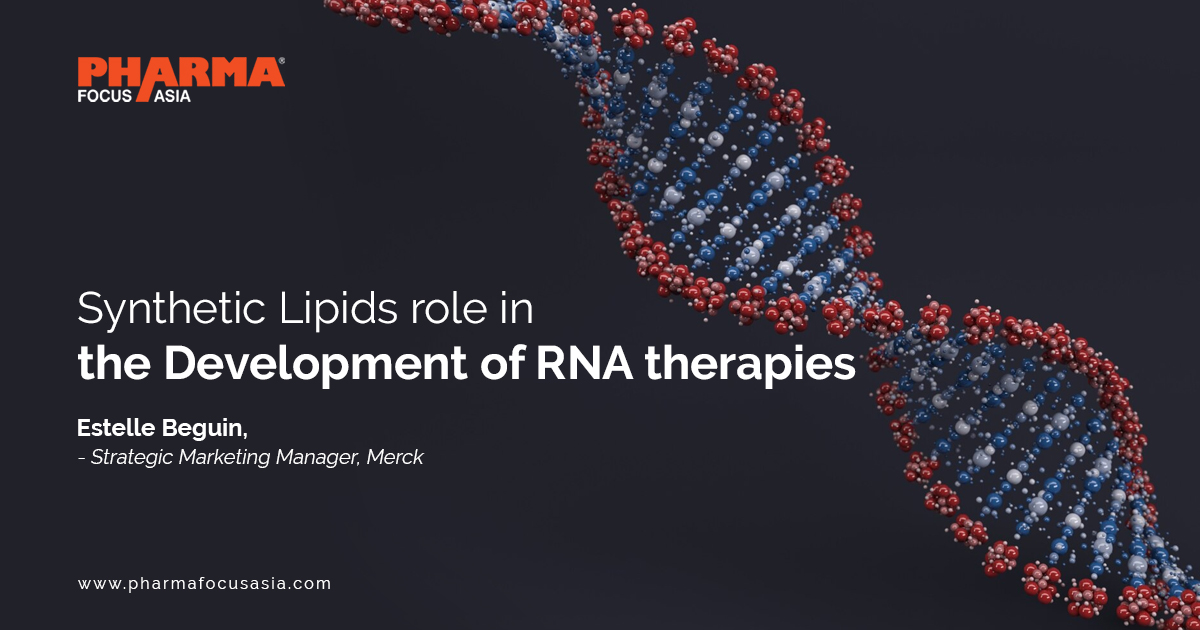Synthetic Lipids role in the Development of RNA therapies

Strong 8k brings an ultra-HD IPTV experience to your living room and your pocket.
Author: Estelle Beguin, Strategic Marketing Manager, Merck
Novel therapies based on nucleic acids are poised to change the way diseases are addressed. These innovative approaches can be used to modulate the expression of one or more proteins simultaneously and enable targeting the source of diseases at the genetic level. Given this mode of action, RNA and DNA therapeutics offer a powerful means to treat, and in some cases cure, diseases in a very efficient way.
In 1998, the first therapeutic nucleic acid, a DNA oligonucleotide, was approved for clinical use. Twenty years later, the first therapeutic RNA-based oligonucleotide was approved by the United States Food and Drug Administration (FDA). The potential of RNA as a therapeutic also made headlines in 2006 when the Nobel Prize in Physiology was awarded for the discovery of gene silencing by RNA interference (RNAi).
Serving as the basis for vaccines targeting SARS-CoV-2, messenger RNA (mRNA) has now become part of everyday conversations. With the rapid availability of the SARS-CoV-2 genetic sequence, the scientific community immediately searched for an effective vaccine against COVID-19. When viral proteins were identified as potential vaccine candidates, mRNA-based systems became front-runners in the development of a vaccine as they can be rapidly designed and have the advantage of being less prone to genome integration (compared to DNA vaccines) and less prone to anti-vector immunity (compared to viral vector vaccines). With their expertise in the field of mRNA, Moderna and BioNTech took the lead in developing COVID-19 vaccines at record speed. The success of these vaccines has now led to a significant increase in preclinical and clinical studies of mRNA applied to other infectious diseases and therapeutic applications.
While nucleic acids are extremely versatile in the way they can be used to modulate gene expression or protein production, they are fragile molecules that would degrade if administered on their own and cleared by the body prior to reaching the site of intended action. Non-viral and viral delivery systems have been developed to promote the stability of nucleic acids and their efficient delivery into the cytoplasm of cells. As part of non-viral systems, lipid nanoparticles (LNPs) have provided effective formulations, including the current mRNA-based COVID-19 vaccines.
The diversity of lipids and LNPs offers a great deal of flexibility when formulating and manufacturing vaccines and therapeutics. The composition of LNPs, for example, influences the encapsulation efficiency of the RNA, its biodistribution, and how well it will be released into cells. In addition, these lipids are in direct interaction with the biological environment from the onset of administration. As such, their composition directly influences where and how the RNA is going to be delivered.
Ensuring Quality and Consistency
The quality and consistency of lipids used in formulation are essential for success. Lipid type, source and quality must be carefully considered as these can have a direct impact on the impurity profile and properties of the final drug product. Additionally, the choice of lipids affects other particle characteristics such as structure, stability, and release properties.
Generally, LNPs are comprised of four different lipids that must be of high purity and consistent quality to ensure reproducibility in the manufacture of the final drug product. It is particularly important, for example, to control impurities like trans fatty acids in lipids because these can alter certain characteristics of the formulation, including particle stability and RNA release. Finally, the use of chemically synthesized lipids can have a significant advantage over natural lipids because synthetic lipids are made of a single lipid of known quality and are also less prone to batch-to-batch variability.
Ensuring a Global Supply
During the pandemic, when so many RNA-based vaccines were being developed, the industry was in urgent need of a large supply of consistent, very high-quality lipids. Fortunately, we had the appropriate network, expertise, and supply capabilities within our global organization and our SAFC® portfolio to fully support companies developing vaccines against COVID-19 from the earliest days of the pandemic’s onset.
To date, we have collaborated with more than 50 companies to support their development and production of COVID-19 vaccines and treatments. In February 2021, we extended our strategic partnership with BioNTech to accelerate the supply of urgently needed lipids to the end of 2021. These lipids are now being used in the production of the Pfizer-BioNTech COVID-19 vaccines.
Our lipids portfolio was supporting customers long before the pandemic. We have over 24 years of experience developing and manufacturing high-quality GMP lipids and a track record of product success in a wide variety of therapeutic applications. Through our SAFC® portfolio we provide off-the-shelf and custom lipids, as well as other critical raw materials, and through our Millipore® portfolio we provide processing equipment for mRNA drug and vaccine manufacturing.
EXPLORE MORE: https://www.pharmafocusasia.com/articles/synthetic-lipids
Note: IndiBlogHub features both user-submitted and editorial content. We do not verify third-party contributions. Read our Disclaimer and Privacy Policyfor details.


